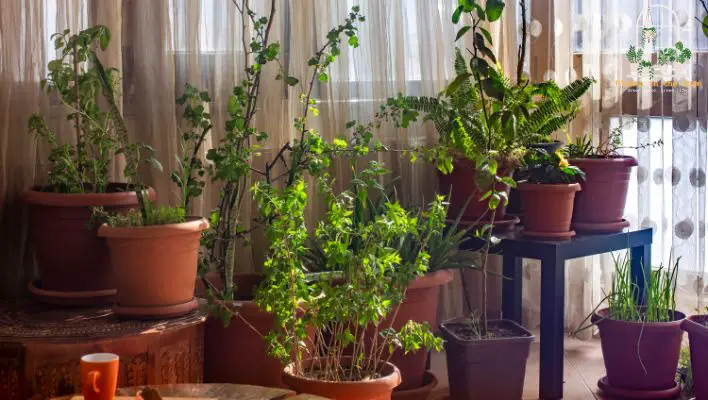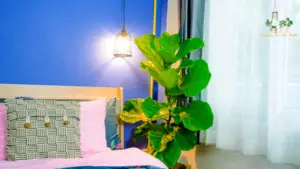This article covers the following areas –
- Understand Your Space and Lighting Conditions
- Guide to Choosing the Right Corner Plants
- Creative Ideas for Utilizing Corner Spaces with Plants
- How to Take Care of Your Corner Houseplants?
- In Conclusion
A common design challenge in many homes is effectively figuring out how to utilize the often-underestimated corner spaces. These corners can become functional, beautiful, and vibrant parts of your home with creative solutions. Incorporating indoor plants into these spaces is a fantastic way to breathe life into these corners and enhance your home’s overall aesthetic. However, if you are wondering how to do it, this post is for you.
Utilizing corner spaces with plants involves understanding your space, assessing the lighting conditions, choosing suitable plants, and creatively displaying them. Options include using plant stands, hanging plants, creating vertical plant walls, or setting up a plant ladder.
For a more comprehensive guide on how to utilize corner spaces with plants, continue reading. This guide covers everything from understanding your space, lighting conditions, and selecting the right plants, to creative display ideas such as plant stands, shelves, hanging plants, vertical plant walls, and plant ladders. Plus, there’s a section dedicated to plant care tips to keep your indoor oasis thriving.
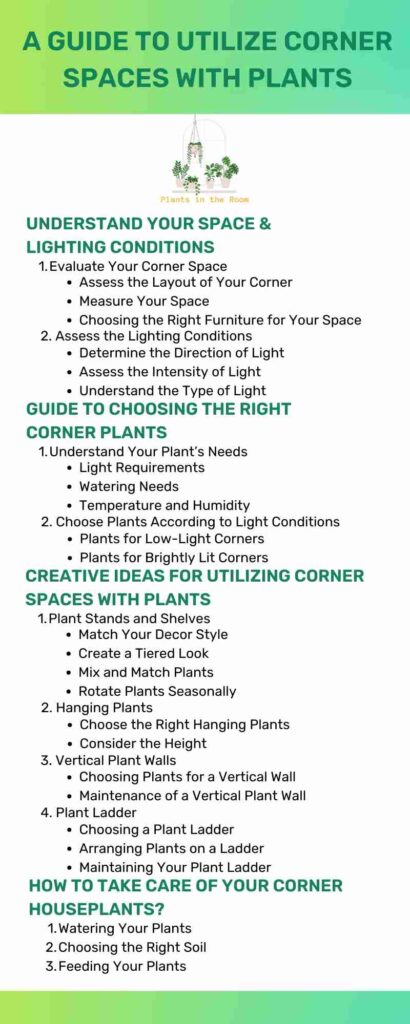
Understand Your Space and Lighting Conditions
Before you dive into the world of indoor plants and start transforming your corner spaces into lush, green sanctuaries, it is crucial to understand your space and lighting conditions. The success of your indoor garden depends on the interplay between your chosen plants and their environment.
This requires considering the corner’s size, layout, light exposure, and the specific needs of the plants you plan to introduce. In this section, we will delve into the practical steps of evaluating your corner space and assessing the lighting conditions, offering guidelines to help you ensure your plants not only survive but thrive.
1. Evaluate Your Corner Space
Before you begin, evaluating the corner space you intend to utilize is essential. Measure the space to get an understanding of its size and figure out how much room you have to work with. Consider the height, width, and depth to ensure the plants you choose will fit comfortably without overcrowding.
Assess the Layout of Your Corner
- Visibility: Check how visible the corner is from different parts of the room. The more visible it is, the more impact your plant arrangement will have.
- Accessibility: Consider how easy it will be to water the plants, prune them, and carry out other maintenance tasks. If it’s hard to reach, it might be best to choose low-maintenance plants.
- Ventilation: Check if the corner is near a heating or cooling vent. Some plants can suffer from drafts or from direct hot or cold air blasts.
Measure Your Space
- Height: Measure the vertical space available. Tall corners may accommodate a tall plant or multiple plants on a shelving unit.
- Width & Depth: Measure the horizontal space (both width and depth). This will guide you on the size of the plant pots or stands that you can place.
Choosing the Right Furniture for Your Space
- Small Corners: If your space is small, floating shelves or wall-mounted planters could be a good fit.
- Medium Corners: A corner plant stand can be ideal for medium-sized spaces. It can host several plants without overwhelming the area.
- Large Corners: Consider a plant ladder or a large statement plant, like a fiddle leaf fig or monster, for a large corner.
By understanding and evaluating your corner space effectively, you can ensure that you’re choosing the best plants and arrangements for your needs. In the next section, we’ll delve into assessing your lighting conditions, another crucial aspect of indoor gardening.
2. Assess the Lighting Conditions
Different plants require different light conditions. Therefore, understanding the amount of light your corner receives throughout the day is crucial. Pay attention to whether the light is direct or indirect and whether it’s strong or low-intensity. Below, I’ll expand on correctly assessing the lighting conditions in your corner space and choosing plants that will thrive under those conditions.
Determine the Direction of Light
Understanding the direction from which your corner receives light can inform your choice of plants and their arrangement. Here’s a basic guide:
- North-facing corners: These spaces typically get little to no direct sunlight but have consistent indirect light throughout the day. They’re great for shade-loving plants like ferns or snake plants.
- South-facing corners: These corners are brightly lit for most of the day and are ideal for plants that love sunlight, like succulents or citrus plants.
- East-facing corners: These corners get gentle morning light and are great for most plants, including popular options like pothos or peace lilies.
- West-facing corners: These corners receive intense afternoon light and can host sun-loving plants that can tolerate the heat.
Assess the Intensity of Light
Observe the intensity of light your corner receives at different times of the day. Here are some guidelines:
- Low light: Low light does not mean no light. You have low light if you can read in the corner without turning on any lights. Suitable plants include ZZ plants or snake plants.
- Medium-light: You have medium light if the corner is well-lit but doesn’t get direct sunlight. Plants like peace lilies or spider plants are good options here.
- Bright light: If your corner gets several hours of direct sunlight per day, you have bright light. Succulents, cacti, and other sun-loving plants will thrive here.
Understand the Type of Light
Finally, it’s also essential to understand whether the light your corner receives is direct or indirect:
- Direct light: Direct light means the sunlight hits the plant leaves without any obstruction. Direct light is best for sun-loving plants but can burn the leaves of shade-loving or delicate plants.
- Indirect light: Indirect light is sunlight that has been diffused or has bounced off other surfaces. Many houseplants, like pothos or philodendrons, thrive in bright, indirect light.
Assessing the lighting conditions in your corner spaces will help ensure your plants have the best environment to thrive and grow. In the next section, we’ll delve into choosing the right plants for your space and light conditions.
Guide to Choosing the Right Corner Plants
Now that you’ve evaluated your corner space and assessed its lighting conditions, it’s time to embark on one of the most enjoyable aspects of indoor gardening – choosing the right plants. Selecting the perfect plants requires a blend of understanding your environmental conditions and personal preferences.
The options are plentiful, from shade-loving ZZ plants for darker corners to sun-craving succulents for bright areas. This section will provide a detailed guide to help you choose plants that will thrive in your unique corner spaces, turning them into vibrant, green havens.
1. Understand Your Plant’s Needs
Before you select your plants, it’s crucial to understand that each plant species has unique needs. These needs encompass lighting, watering, temperature, and humidity requirements. Always research each plant’s specific needs before purchasing.
Light Requirements
As mentioned earlier, some plants thrive in shady corners, while others need a lot of sunlight. Make sure the plants you choose match the light conditions of your corner.
Watering Needs
Some plants require frequent watering, while others are drought-tolerant. Make sure you can provide the watering regime your chosen plant requires.
Temperature and Humidity
Certain plants, like ferns, prefer a cooler, more humid environment, while others, like cacti, prefer a warm, dry climate. Try to match the plant’s preferences to your home’s conditions.
2. Choose Plants According to Light Conditions
Now that you understand your plants’ needs, let’s look at some specific plants for different light conditions.
Plants for Low-Light Corners
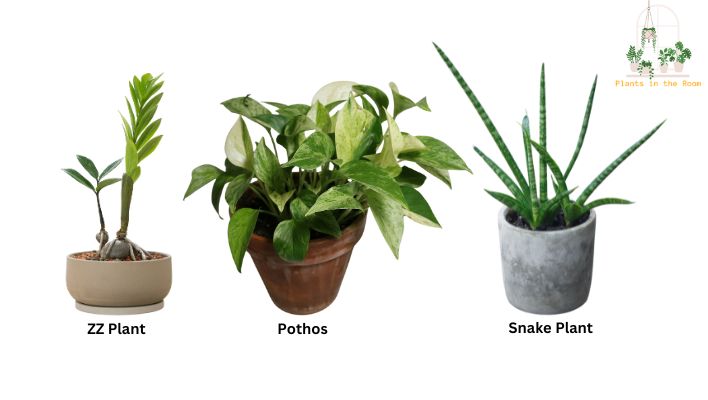
- ZZ Plant: ZZ plants are extremely hardy and can tolerate low light conditions, making them a perfect choice for shady corners.
- Snake Plant: Snake plants are another excellent choice for low-light conditions. They’re also very low-maintenance.
- Pothos: Pothos is a versatile plant that can tolerate a range of light conditions, including low light.
Plants for Brightly Lit Corners
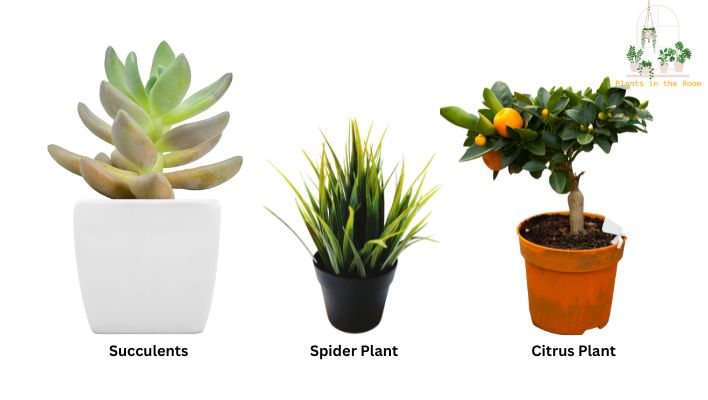
- Succulents: Succulents like aloe vera, echeveria, or jade plants love sunlight and are perfect for brightly lit corners.
- Spider Plant: Spider plants can tolerate a lot of sunlight and are easy to care for, making them a great choice for sunny corners.
- Citrus Plants: If your corner gets a lot of sunlight, consider a small citrus plant, like a lemon or lime tree.
Remember, choosing the right plant involves considering both the plant’s needs and your ability to meet those needs. With a thoughtful approach, you’ll be well on your way to creating a thriving indoor garden in your corner space. In the next section, we’ll explore some creative ideas for arranging these plants in your corner space.
Creative Ideas for Utilizing Corner Spaces with Plants
So far, we have explored how to understand your corner space, assessed lighting conditions, and choose the right plants for your area. Now, let’s take it a step further. Just having plants isn’t enough; how you present them can significantly influence the overall aesthetic appeal of your corner.
When creatively displayed, plants can transform a simple corner into a stylish, vibrant oasis that truly stands out. This section’ll cover some innovative ideas for utilizing corner spaces with plants, starting with plant stands and shelves.
1. Plant Stands and Shelves
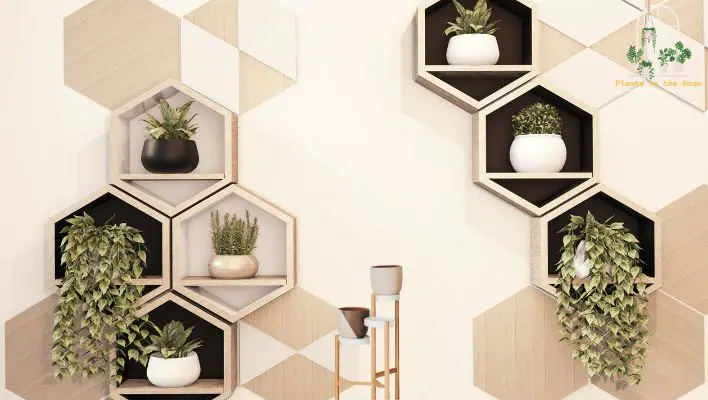
Plant stands, and shelves can be excellent solutions for utilizing corner spaces with plants. They allow you to display multiple plants at different heights, creating a dynamic, layered look. You can choose stands or shelves that match your decor for a harmonious look or a contrasting style to create a focal point. Here are some ideas for getting the most out of plant stands and shelves.
Match Your Decor Style
Choose plant stands and shelves that complement your existing decor. If your home has a modern aesthetic, consider sleek, minimalistic stands or shelves in materials like metal or glass. If your decor is more rustic, look for stands or shelves made of reclaimed wood or wicker.
Create a Tiered Look
Use plant stands of different heights or shelves with several tiers to create a layered look. This can add depth and interest to your corner and allows you to display multiple plants in a small space.
Mix and Match Plants
Combine plants of different sizes, shapes, and colors on your stands or shelves to create a visually interesting display. For example, you could pair a tall snake plant with trailing pothos and a small, colorful bromeliad.
Rotate Plants Seasonally
Consider changing your plant display with the seasons. You might display plants with bright, colorful flowers in the spring and summer. You could switch to plants with interesting foliage or textures in the fall and winter.
2. Hanging Plants
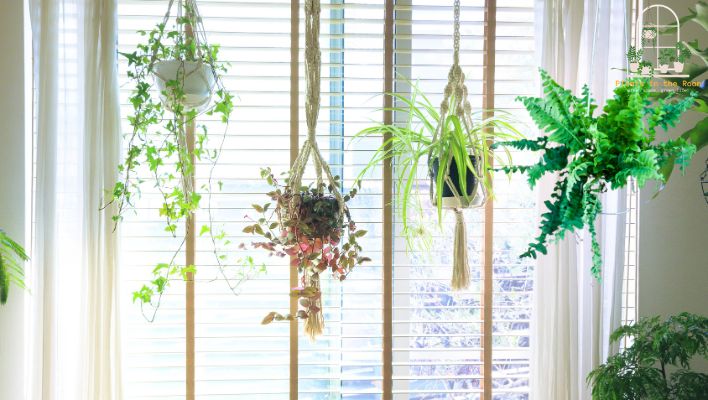
If floor space is at a premium, consider incorporating hanging plants into your design. Hanging plants can create a dynamic visual appeal and help purify your home’s air. Whether in macrame plant hangers or modern hanging planters, plants that cascade over their containers bring a unique charm to any corner.
Choose the Right Hanging Plants
Not all plants are suitable for hanging baskets. Choose plants that naturally trail or vine. Here are a few recommendations:
- English Ivy: Known for its beautiful trailing vines, English ivy can be a perfect addition to your hanging corner arrangement.
- Spider Plants: Spider plants are hardy, easy to care for, and their arching leaves look great in hanging baskets.
- Ferns: Many ferns, such as Boston or maidenhair ferns, have a natural trailing growth habit that is perfectly suited to hanging displays.
Consider the Height
The height at which you hang your plants will depend on the size of the plant, the length of its trailing vines, and the height of your ceiling. Ensure the plants are hung at a height that can be easily cared for.
3. Vertical Plant Walls
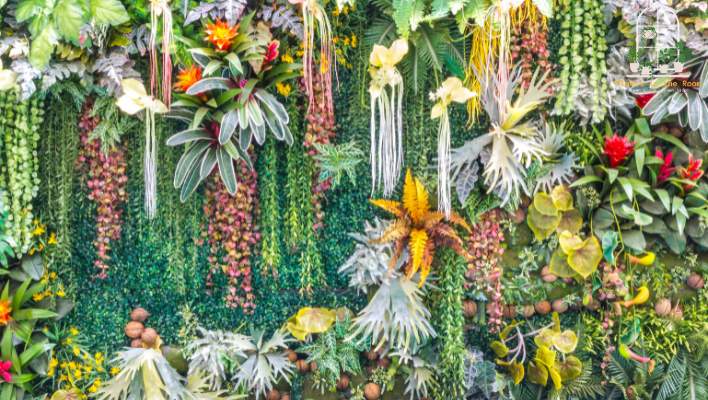
If you’re feeling a bit adventurous, a vertical plant wall could be the perfect solution for you. These living walls can bring a striking, lush green look to your corner spaces. Whether you choose to buy ready-made vertical planters or prefer a DIY project, a vertical plant wall can transform an ordinary corner into a breathtaking green display.
Choosing Plants for a Vertical Wall
When creating a vertical plant wall, opt for small, low-maintenance plants that can thrive in the light conditions of your corner. Some good choices might be:
- Pothos: Pothos is an excellent plant for vertical gardens because of its trailing habit and low-maintenance nature.
- Succulents: Various succulents can thrive in vertical gardens, creating a modern, textural look.
- Ferns: Ferns can give your vertical wall a lush, tropical feel. Just make sure your corner has enough humidity to keep them happy.
Maintenance of a Vertical Plant Wall
While a vertical plant wall can look spectacular, it does require a bit more maintenance than potted plants. Ensure all the plants are getting enough water and light, and regularly check for any signs of pest infestations or disease.
4. Plant Ladder
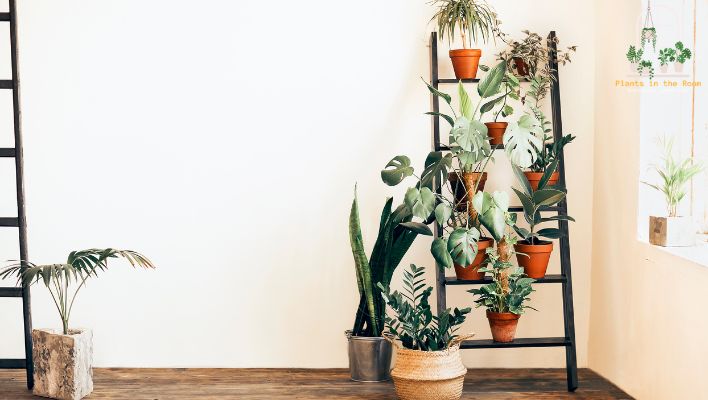
A plant ladder is a stylish and functional solution to maximize corner spaces with plants. Much like a bookshelf or a rack, a plant ladder can accommodate several plants, allowing you to create a mini vertical garden in your corner. It’s a perfect way to display your favorite indoor plants without taking up too much floor space.
Choosing a Plant Ladder
Plant ladders come in a variety of styles and materials, so you can find one that fits your aesthetic and functional needs. Here are a few things to consider when choosing a plant ladder:
- Material: Plant ladders are available in a range of materials, including wood, metal, and bamboo. Choose a material that complements your decor and can support the weight of your plants.
- Size: Consider the height and width of the plant ladder in relation to your corner space. Ensure it’s not too large for your corner but has enough room to accommodate your plants.
- Number of Rungs: The number of rungs on the ladder will determine how many plants you can display. Keep in mind that each plant needs adequate space to grow.
Arranging Plants on a Ladder
When arranging plants on a ladder, consider the following:
- Light Requirements: Place plants that need more light on the top rungs and those that can tolerate lower light conditions on the bottom.
- Size and Shape: Larger plants or those with sprawling foliage might be better placed on the top or bottom rungs to give them space to grow, while smaller plants can go on the middle rungs.
- Visual Appeal: Experiment with different arrangements until you find one that is visually pleasing to you. This might mean grouping plants with similar leaf shapes together or creating a gradient of leaf colors from top to bottom.
Maintaining Your Plant Ladder
Maintaining a plant ladder is similar to caring for other indoor plants. You’ll need to water your plants regularly, ensure they’re getting the right amount of light, and rotate them occasionally so they grow evenly. If your ladder is made of a material like wood, you may also need to clean it occasionally to keep it looking its best.
A plant ladder can be a wonderful addition to your corner, allowing you to display your plants in a unique and attractive way. As always, keep the needs of your individual plants in mind as you create your corner garden, and enjoy the process of nurturing your indoor oasis.
How to Take Care of Your Corner Houseplants?
Designing and arranging your corner garden is just the first step in the process. Providing your plants with the right care is essential to keep your corner oasis vibrant and healthy. Each plant type has specific needs and preferences, but there are general guidelines you can follow to ensure your plants thrive.
This section will delve into the fundamental aspects of plant care, including watering, soil selection, and feeding your plants. Providing consistent care will ensure your plants continue to enhance your space with their beauty and vitality.
1. Watering Your Plants
Just like humans, plants need water to survive. However, different plants have different water requirements. Overwatering or underwatering can harm your plants, so finding the right balance is crucial.
Some plants need their soil to dry out completely between waterings, while others prefer consistently moist soil. Make sure you understand the water needs of each of your plants to keep them healthy.
Aim for the soil, not the leaves or stems, when watering your plants, as this could cause rot or disease. Ensure the water reaches the roots by watering until it drains out the bottom of the pot.
2. Choosing the Right Soil
The soil you use plays a crucial role in the health of your plants. It provides your plant’s roots with a home and supplies them with the nutrients they need.
Different plants have different soil requirements. Some prefer sandy, well-draining soil, while others need a richer, more organic mix.
If your plant isn’t thriving and you’ve ruled out other issues like light or water, consider whether your soil might be the problem. You might need to amend your soil with organic matter or a specific soil mix to make it more suitable for your plant.
3. Feeding Your Plants
Just like us, plants need nutrients to grow. In nature, plants get these nutrients from the soil, but indoors, you might need to supplement with plant food or fertilizer.
Different plants have different nutrient needs. Make sure the plant food you choose is appropriate for your type of plant.
Don’t overfeed your plants – more is not always better. Follow the plant food package instructions to avoid over-fertilizing, which can harm your plants.
Remember, the key to plant care is consistency and attention. By observing your plants and responding to their needs, you can keep your corner garden healthy and beautiful.
In Conclusion
With a bit of creativity and planning, those underutilized corner spaces in your home can become vibrant, green sanctuaries. Whether you prefer a minimalist look with a single statement plant or a lush, verdant corner brimming with a variety of plants, the possibilities are endless. Happy decorating!

